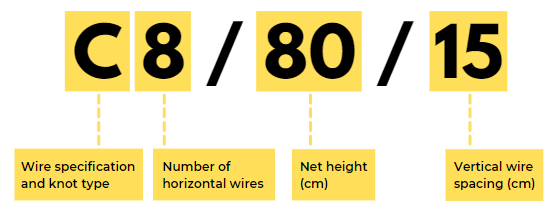Hot Weather Incoming – Are You Ready? Stock up now on essentials to beat the heat.

Stock Fencing
Stock fencing is a heavy-duty wire fence that, when installed, forms a high tensile barrier capable of enclosing large livestock. It is often used in conjunction with barbed wire... read more
On sale
Tornado C8/80/15 | Mild Steel Stock Fencing
- SKU: 998925-998932
- Weight: 32kg-64kg
- Length: 50m, 100m
- Brands: Tornado
- Quantity: 1 pack
Tornado R8/80/22 | Torus High Tensile Stock Fencing
- SKU: 998949
- Weight: 50kg
- Length: 100m
- Brands: Tornado
Tornado | Equi Horse Torus Fence | R12/110/8-100m
- SKU: 998956
- Weight: 119kg
- Length: 100m
- Height: 1100mm
- Brands: Tornado
Tornado R6/85/22 | Pheasant/Game Grippled Stock Fence | 100m
- SKU: 872994
- Weight: 41.4kg
- Height: 850mm
- Brands: Tornado
Stock fencing is a heavy-duty wire fence that, when installed, forms a high tensile barrier capable of enclosing large livestock. It is often used in conjunction with barbed wire or electric fencing. We supply both own-label and branded stock fencing from Tornado Wire, Uniwire and Hampton Steel.
What do the numbers mean on stock fencing?
Although the codes used to denote the specification of stock fencing may appear confusing, they consist of 4 simple pieces of information. Understanding these details will help you to select the right stock fence:
- The letter(s) indicate the wire type and knot configuration used in the net.
- The first number indicates the number of horizontal wires (or ‘line wires’) in the net.
- The second number indicates the overall height of the net (in centimetres).
- The third number indicates the distance (in centimetres) between the vertical stay wires in the net.
What does C8 80 15 mean?
C8/80/15 means the wire has 8 horizontal wires and is 80cm high with 15cm between vertical stay wires.

What fencing wire sizes do you have available?
We supply stock fencing in diameters 3.00mm and 2.50mm to suit agricultural, commercial and domestic garden fencing requirements. These are available in 50m and 100m lengths.
We also supply galvanised and PVC-coated straining line wire in diameters 2mm, 2.5mm and 3.15mm. These are available in a coil in lengths 50m, 100m, 150m and 250m.
If you are looking for thinner wire, we would advise looking at our wire panels, wire rolls and hexagonal mesh which are available in diameters 0.71mm, 0.91mm, 1.02mm, 1.2mm, 1.42mm, 1.63mm, 1.83mm, 2.03mm, 2.64mm, 3.25mm and 4.11mm. These are available in a variety of panel sizes from 6x3ft to 8x4ft and roll lengths from 10m up to 30m to suit your requirements.
How far apart should stock fence posts be?
Stock fence post spacing varies according to the type of wire and the conditions. For example, high tensile wire strains tighter than mild steel and so requires fewer intermediate posts, making it quicker to erect. For standard mild steel wire, posts should be 8 to 12 feet apart, but with high tensile stock fencing, straining posts can be spaced 20ft apart or at every major change in direction.
Should I use high tensile or mild steel stock fencing?
Although high tensile stock fencing is now generally preferred, mild steel fencing may still be suitable in certain situations such as when patching up an existing fence or doing a short run of fencing. The benefits of mild steel fencing include:
- Does not need to be strained as tightly as high tensile
- Useful if you need to make a lot of turns in your fence line
- Cost-effective solution where fencing is supported by background hedges
High tensile stock fencing, on the other hand, offers maximum strength, security and longevity. It offers maximum protection with minimal lifestyle costs and does not stretch with weathering meaning it does not need to be retightened annually. High tensile stock fencing strains tighter than mild steel and so requires fewer intermediate posts, making it quicker and more cost-effective to install. High tensile stock fencing can be used for sheep, cows, horses, deer and badgers.
How do you erect/fit stock fencing?
We have installation guidelines on-hand for all our Tornado fencing range, meaning you can be confident that you have the right product for your application and installed in the right way. If you need any further assistance in selecting the best possible fence for the job at-hand, please do not hesitate to contact our dedicated service team on sales@sure-green.com or 01376 503869.








